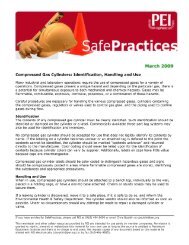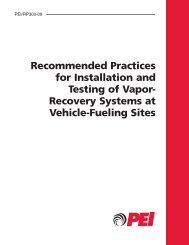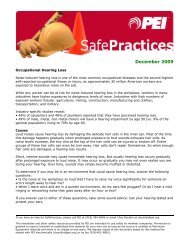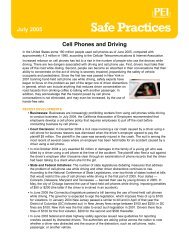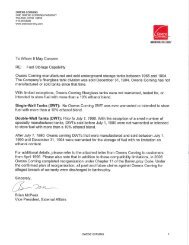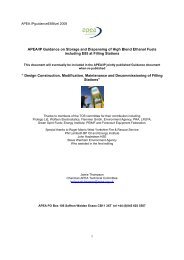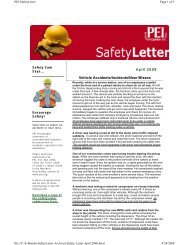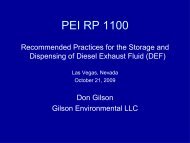- Page 1 and 2: The Administrator signed the follow
- Page 3 and 4: DATES: Comments must be received on
- Page 5 and 6: Category NAICS 1CodesIndustryIndust
- Page 7 and 8: 3. Renewable Fuel Exempt from 20 Pe
- Page 9 and 10: E. Concept for EPA Moderated Transa
- Page 11 and 12: F. Total GHG Emission ReductionsG.
- Page 13 and 14: XI.C. Additional Water Issues1. Che
- Page 15 and 16: I. IntroductionThe current Renewabl
- Page 17 and 18: analyzed the lifecycle GHG impacts
- Page 19 and 20: II.Overview of the Proposed Program
- Page 21 and 22: iofuel or biomass-based diesel is a
- Page 23 and 24: For other renewable fuels, EISA mak
- Page 25 and 26: of important trends in agricultural
- Page 27 and 28: not been assessed to participate in
- Page 29 and 30: finalized. Rather, the current RFS1
- Page 31 and 32: However, for the 2010 compliance ye
- Page 33 and 34: In a similar fashion, while we reco
- Page 36 and 37: for the final rule, along with impa
- Page 38 and 39: Table II.B.3-1 RFS2 “Less Sensiti
- Page 40 and 41: the leading problems facing our nat
- Page 42 and 43: II.B.5-1 summarizes the changes in
- Page 44 and 45: the RFS program and minimizing the
- Page 48 and 49: Section III.B.4 of this preamble ou
- Page 50 and 51: “Advanced biofuel” also may be
- Page 52 and 53: must therefore specify whether or n
- Page 54 and 55: sugarcane sugar has been estimated
- Page 56 and 57: Air Act, served this purpose. (40 C
- Page 58 and 59: enewable fuels produced by the faci
- Page 60 and 61: limit the initial grandfathering on
- Page 62 and 63: value of the modifications exceeds
- Page 64 and 65: (2) Expiration date of 15 years for
- Page 66 and 67: would be 15 years from the time the
- Page 68 and 69: a. Definitions of TermsEISA’s des
- Page 70 and 71: Therefore, we believe that there ma
- Page 72 and 73: option, and specifically request co
- Page 74 and 75: specify in the regulations a time p
- Page 76 and 77: propose to adopt the definition of
- Page 78 and 79: iv.Biomass Obtained from Certain Ar
- Page 80 and 81: The effect of adding EISA's definit
- Page 82 and 83: and a concurrent increase in the pr
- Page 84 and 85: We also examined third-party organi
- Page 86 and 87: their feedstock does not meet the d
- Page 88 and 89: definition of renewable biomass, bu
- Page 90 and 91: producers would also be delayed. Du
- Page 92 and 93: enewable fuel for which RINs were g
- Page 94 and 95: Under the existing RFS1 program, pr
- Page 96 and 97:
already. However, the foreign renew
- Page 98 and 99:
2. All liquid renewable fuels would
- Page 100 and 101:
The same amount of petroleum energy
- Page 102 and 103:
ethanol made from corn stover or sw
- Page 104 and 105:
For RFS2 we are proposing a similar
- Page 106 and 107:
Our proposed approach to foreign pr
- Page 108 and 109:
describe its feedstock(s), fuel typ
- Page 110 and 111:
amount of the different types of fe
- Page 112 and 113:
energy in the fossil feedstock. Jus
- Page 114 and 115:
Under our proposed approach, the pr
- Page 116 and 117:
will not replace or supersede other
- Page 118 and 119:
1. Calculation of Standardsa. How W
- Page 120 and 121:
enewable fuel use in the equations
- Page 122 and 123:
GE i =DE i =The amount of gasoline
- Page 124 and 125:
No adjustment was made for small re
- Page 126 and 127:
fuel for 2009. As described in Sect
- Page 128 and 129:
approach would also require that we
- Page 130 and 131:
Similarly, the combination of the 0
- Page 132 and 133:
The above discussion assumes that t
- Page 134 and 135:
As discussed above in Section II.A.
- Page 136 and 137:
lendstocks and unfinished fuels as
- Page 138 and 139:
In 2009, the RFS1 regulations will
- Page 140 and 141:
4. Alternative Approach to Designat
- Page 142:
approach to RIN distribution as des
- Page 145 and 146:
the resulting expansion in the numb
- Page 147 and 148:
enewable fuel with gasoline or dies
- Page 149 and 150:
than they needed, another company m
- Page 151 and 152:
emaining obligated parties to purch
- Page 153 and 154:
Monthly Reporting ScheduleMonth Cov
- Page 155 and 156:
information (e.g. the average price
- Page 157 and 158:
determination about the adequacy of
- Page 159 and 160:
IV.What Other Program Changes Have
- Page 161 and 162:
a. Extension of Existing RFS1 Tempo
- Page 163 and 164:
and a consideration of EPA’s ongo
- Page 165 and 166:
enewable fuel per year. We also req
- Page 167 and 168:
higher volume requirements. However
- Page 169 and 170:
transaction report is to document R
- Page 171 and 172:
oth the buyer and the seller upon c
- Page 173 and 174:
damage to the vehicle. 45 We antici
- Page 175 and 176:
Table V.A.1-1 AEO 2007 Reference Ca
- Page 177 and 178:
Table V.A.2-1 Control Case Projecte
- Page 179 and 180:
European market with diesel fuel an
- Page 181 and 182:
The economic competitiveness of cel
- Page 183 and 184:
production of RD is currently under
- Page 185 and 186:
Butanol is another potential motor
- Page 187 and 188:
is not limited due to environmental
- Page 189 and 190:
and less than half a percent is pro
- Page 191 and 192:
Since the majority of ethanol is ma
- Page 193 and 194:
Table V.B.1-4 Potential Industry Ex
- Page 195 and 196:
Table V.B.1-6 Projected Near-Term C
- Page 197 and 198:
cellulosic diesel plant in addition
- Page 199 and 200:
To date, the majority of cellulosic
- Page 201 and 202:
Increased public interest, governme
- Page 203 and 204:
Company or Organization NameTable V
- Page 205 and 206:
energy intensity of ethanol product
- Page 207 and 208:
today and which incurs a fee for it
- Page 209 and 210:
Sustainable removal rates for agric
- Page 211 and 212:
could be available for producing bi
- Page 213 and 214:
In addition to estimating the exten
- Page 215 and 216:
Table V.B.2-5 Projected Cellulosic
- Page 217 and 218:
Ethanol imports have traditionally
- Page 219 and 220:
consumption estimates. The most cur
- Page 221 and 222:
From there, we looked at 2006-2007
- Page 223 and 224:
Table V.B.4-1U.S. Biodiesel Capacit
- Page 225 and 226:
processed with petroleum (thus proh
- Page 227 and 228:
number of companies and universitie
- Page 229 and 230:
transport by pipeline. However, the
- Page 231 and 232:
USDA estimated that in 2005 approxi
- Page 233 and 234:
volumes also tend to be smaller tha
- Page 235 and 236:
We intend to incorporate the result
- Page 237 and 238:
Given the broad importance to the U
- Page 239 and 240:
classified as hazardous liquids. Th
- Page 241 and 242:
producing E85, and whether we shoul
- Page 243 and 244:
lower energy density of ethanol. Th
- Page 245 and 246:
eing consumed by today’s vehicle
- Page 247 and 248:
The maximum amount of ethanol our c
- Page 249 and 250:
There are a number of states promot
- Page 251 and 252:
According to a recent online fuel p
- Page 253 and 254:
to gasoline) by 2012. This number w
- Page 255 and 256:
directs the Administrator of EPA to
- Page 257 and 258:
egulations including those pertaini
- Page 259 and 260:
may be that certain vehicles and en
- Page 261 and 262:
had pumps dispensing both leaded an
- Page 263 and 264:
Prior to and after 1981, several wa
- Page 265 and 266:
contain up to 2.7% by weight oxygen
- Page 267 and 268:
marketplace. In addition, the subst
- Page 269 and 270:
States and also those that occur in
- Page 271 and 272:
changes in agricultural commodity p
- Page 273 and 274:
1. Scenario DescriptionTo quantify
- Page 275 and 276:
the refinery, the production of gas
- Page 277 and 278:
for uncertainty in our estimates, i
- Page 279 and 280:
Currently, no single model can capt
- Page 281 and 282:
conversions. Winrock has used 2001-
- Page 283 and 284:
can relatively accurately capture e
- Page 285 and 286:
working with Colorado State Univers
- Page 287 and 288:
We are also addressing GHG emission
- Page 289 and 290:
increasing productivity on existing
- Page 291 and 292:
iii.What Type of Land is ConvertedI
- Page 293 and 294:
come from grassland, 45% of that la
- Page 295 and 296:
changes in particular in other coun
- Page 297 and 298:
diesel. In simulating land use chan
- Page 299 and 300:
enefits may be small compared to th
- Page 301 and 302:
decreased, it is likely that renewa
- Page 303 and 304:
assessing the stream of GHG benefit
- Page 305 and 306:
the reduction in GHG emissions. 295
- Page 307 and 308:
Therefore, lower discount rates suc
- Page 309 and 310:
appropriately reflects the uneven r
- Page 311 and 312:
combustion of biomass fuel source a
- Page 313 and 314:
marginal displacement approach and,
- Page 315 and 316:
a. Corn EthanolTable VI.C.1-1 prese
- Page 317 and 318:
local market is available such as a
- Page 319 and 320:
Table VI.C.1-3 Corn Ethanol Lifecyc
- Page 321 and 322:
will not significantly impact other
- Page 323 and 324:
In addition, FASOM predicts that sw
- Page 325 and 326:
International Land UseChange 2,474,
- Page 327 and 328:
Assessments are made in comparison
- Page 329 and 330:
D. ThresholdsEISA established GHG t
- Page 331 and 332:
The lifecycle analyses that we cond
- Page 333 and 334:
2. Assignments for Pathways Subject
- Page 335 and 336:
3. Assignments for Additional Pathw
- Page 337 and 338:
the land use impacts could signific
- Page 339 and 340:
would need to use a minimum of 48%
- Page 341 and 342:
generic renewable fuel. Therefore,
- Page 343 and 344:
EthanolEthanolBiodiesel (monoalkyl
- Page 345 and 346:
As stated earlier, there may be oth
- Page 347 and 348:
• We estimate the largest overall
- Page 349 and 350:
coupled with the MAGICC (Model for
- Page 351 and 352:
The results in Table VI.G.2-1 and F
- Page 353 and 354:
VII.How Would the Proposal Impact C
- Page 355 and 356:
PM2.5 14,321 0.4% 11,452 0.3% 5,376
- Page 357 and 358:
The fuel production and distributio
- Page 359 and 360:
As shown in Tables VII.C-1 and VII.
- Page 361 and 362:
1. Current Levels of PM 2.5 , Ozone
- Page 363 and 364:
known and well-established tool and
- Page 365 and 366:
Ground-level ozone pollution is typ
- Page 367 and 368:
effects from exposure to the class
- Page 369 and 370:
increased proliferation of bone mar
- Page 371 and 372:
The IARC has classified “alcoholi
- Page 373 and 374:
diesel exhaust compared with evapor
- Page 375 and 376:
in these areas. For more informatio
- Page 377 and 378:
concrete and limestone. Particles c
- Page 379 and 380:
379
- Page 381 and 382:
Table VIII.A.1-1a Projected 2022 Br
- Page 383 and 384:
ethanol plants in the U.S. Likewise
- Page 385 and 386:
operations, or is available from mi
- Page 387 and 388:
must be sorted at the facility. Thi
- Page 389 and 390:
install secondary storage. We assum
- Page 391 and 392:
Thermochemical or gasification unit
- Page 393 and 394:
Table VIII.A.1-3 Biochemical Cellul
- Page 395 and 396:
pathway in our analysis and based o
- Page 397 and 398:
there could also be cost and effici
- Page 399 and 400:
Table VIII.A.1-6 Average Imported E
- Page 401 and 402:
unit at a refinery and 33% at rende
- Page 403 and 404:
investment environment and to 2006
- Page 405 and 406:
Table VIII.B.1-1 Estimated Ethanol
- Page 407 and 408:
assumed to be filled first from loc
- Page 409 and 410:
diesel fuel at $53/bbl crude oil, a
- Page 411 and 412:
estimated first, compared to the co
- Page 413 and 414:
Table VIII.D.2-2 Total Projected U.
- Page 415 and 416:
IX.Economic Impacts and Benefits of
- Page 417 and 418:
Biofuel Reference Case Control Case
- Page 419 and 420:
production of 90 million tons of co
- Page 421 and 422:
Changes to the global commodity tra
- Page 423 and 424:
it consumed. This compares roughly
- Page 425 and 426:
economy for 2022. The U.S. net expo
- Page 427 and 428:
soliciting comments on how to incor
- Page 429 and 430:
U.S. military costs are excluded fr
- Page 431 and 432:
estimates, and a consistent set of
- Page 433 and 434:
3%, and 7%, where 2% and 3% are con
- Page 435 and 436:
enefit and cost estimates, and the
- Page 437 and 438:
estimates. We are also interested i
- Page 439 and 440:
Though EPA is characterizing the ch
- Page 441 and 442:
Endpoint Pollutant Study Study Popu
- Page 443 and 444:
Nitrogen and SulfateDeposition Welf
- Page 445 and 446:
thirty-five industries of the U.S.
- Page 447 and 448:
Tile drainage is another important
- Page 449 and 450:
Alexander, et al. 524 modeled the s
- Page 451 and 452:
BGY for 2015 to 2022. These volumes
- Page 453 and 454:
2. Ethanol ProductionThere are thre
- Page 455 and 456:
3. Biodiesel PlantsBiodiesel plants
- Page 457 and 458:
XI.Public ParticipationWe request c
- Page 459 and 460:
You may find the following suggesti
- Page 461 and 462:
or for a Federal agency. This inclu
- Page 463 and 464:
sources of petroleum, increase dome
- Page 465 and 466:
on small businesses as a result of
- Page 467 and 468:
The RFS1 program regulations provid
- Page 469 and 470:
small refinery study, specifically
- Page 471 and 472:
accountable process to ensure “me
- Page 473 and 474:
XIII. Statutory AuthorityStatutory
- Page 475 and 476:
80.1452 What are the reporting requ
- Page 477 and 478:
Combined heat and power (CHP), also
- Page 479 and 480:
applicable air permits issued by th
- Page 481 and 482:
for calendar year 2006 (as determin
- Page 483 and 484:
RFV AB,i =RFV RF,i =G i =D i =RG i
- Page 485 and 486:
GV i =DV i =The non-renewable gasol
- Page 487 and 488:
D x = Volume of batch x of diesel p
- Page 489 and 490:
§§ 80.1417-80.1424 [Reserved]§ 8
- Page 491 and 492:
(iii) Foreign producers may generat
- Page 493 and 494:
Non-esterrenewabledieselCellulosicg
- Page 495 and 496:
V s,RF = Standardized volume of the
- Page 497 and 498:
V RIN = EV * V sWhere:V RIN = RIN v
- Page 499 and 500:
(∑RINNUM) BBD,i = Sum of all owne
- Page 501 and 502:
(iii)(iv)RINs generated in 2008 or
- Page 503 and 504:
(d) Any batch-RIN can be divided by
- Page 505 and 506:
RVO BBD,i = The Renewable Volume Ob
- Page 507 and 508:
(a)(b)Renewable fuel blenders who h
- Page 509 and 510:
(3) The waiver must be sent to EPA
- Page 511 and 512:
fuel standards of §80.1405 and the
- Page 513 and 514:
(3) The number of RINs expected to
- Page 515 and 516:
(1) Any producer of renewable fuel
- Page 517 and 518:
(c) Beginning January 1, 2010, any
- Page 519 and 520:
(viii) The total current-year RINs
- Page 521 and 522:
(i) The submitting party’s name.(
- Page 523 and 524:
(4) The date of the transfer.(5) Wh
- Page 525 and 526:
(e)provided by the Bureau of Labor
- Page 527 and 528:
(A)(B)(C)(ii)(iii)(iv)(v)The obliga
- Page 529 and 530:
(4) Independent Third Party Enginee
- Page 531 and 532:
(i) Designation of the transportati
- Page 533 and 534:
(4) United States substantive and p
- Page 535 and 536:
prepared by the foreign refiner as
- Page 537 and 538:
(6) In order to complete the requir
- Page 539 and 540:
(i) The foreign producer, containin
- Page 541 and 542:
(8) In any case where RFS-FRRF prod
- Page 543 and 544:
(6) Any United States importer shal
- Page 545 and 546:
“I hereby certify: (1) That I hav
- Page 547 and 548:
G = the total of the number of gall
- Page 549:
Pursuant to Clean Air Act section 1



